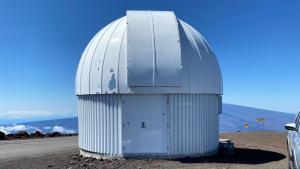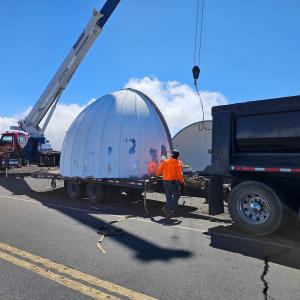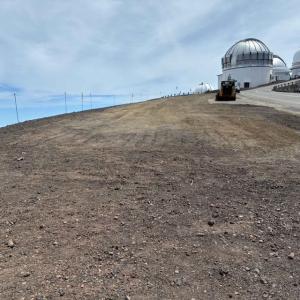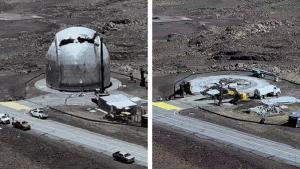Maunakea: 1st telescope decommissioning complete
University of Hawaiʻi at HiloLink to video and sound (details below): https://go.hawaii.edu/WhF
***VOSOT script below for consideration***
A historic milestone on the summit of Maunakea—the first observatory on the summit has been completely removed and the site restored. The decommissioning of the University of Hawaiʻi at Hilo’s Hōkū Keʻa Observatory was completed in May 2024, and the area will be monitored over the next three years to assess species population and diversity.
Once the decommissioning of the Caltech Submillimeter Observatory (CSO) is completed later this year, UH will have honored the commitment made to the UH Board of Regents in 2023 to remove two telescopes before the Maunakea Stewardship and Oversight Authority assumes full management of the summit lands by July 1, 2028. The UH Hilo Center for Maunakea Stewardship (CMS) jointly manages Maunakea with the Maunakea Stewardship and Oversight Authority and is overseeing both decommissioning projects.
“Maunakea warrants the highest levels of stewardship, and we remain steadfast in our collaborative efforts to honor and protect the cultural and environmental significance of this ʻāina,” said UH Hilo Chancellor Bonnie Irwin.“The removal of Hōkū Keʻa reflects the university’s ongoing pledge to reduce the presence of telescopes on Maunakea.”
Management plan guided process
The decommissioning work began in April and cost approximately $1 million. The deconstruction of two buildings and the associated infrastructure and site restoration were done in accordance with the decommissioning process required by the Mauna Kea Comprehensive Management Plan.
“The process to remove Hōkū Keʻa and CSO is being done in a way that is pono to this special place as the construction crews received training on Maunakea’s history, cultural significance, environmental and cultural resources, and health and safety,” said CMS Executive Director Greg Chun. A ceremony was conducted prior to the deconstruction phase and will be conducted again at the projectʻs conclusion and restoration phase.”
Prayers and Native Hawaiian protocol opened and closed each work day. Hawaiʻi Island resident Karl Halemano oversaw both construction and cultural monitoring on site throughout the decommissioning. Morning protocol led by Halemano included E Ala Ē, a chant that welcomes the day.
“We would go up to the site and we would have a pule, oli, mele or just oli and we would start our day so that way we can move forward with a sense of spirituality, the importance of the work we’re doing up there,” Halemano said.
It took 6 dump trucks and 9 trailer loads to remove the debris after the structures were taken down. Fill that had been stored at the summit from when the observatories were first built was used for the site restoration.
Extensive outreach
CMS received approval for the Conservation District Use Application for the project from the Hawaiʻi Board of Land and Natural Resources in 2023.
A final environmental assessment in June 2022 found that the project would have no significant adverse environmental impacts.
Preparation of the assessment included consultation and outreach with the Native Hawaiian community through the preparation of a cultural impact assessment; meetings with Kahu Kū Mauna (Guardians of the Mountain, a volunteer community-based council); and direct outreach to the Office of Hawaiian Affairs along with other native Hawaiian organizations and stakeholders.
CSO decommissioning progress
Decommissioning of CSO is scheduled to be completed by fall 2024. The CSO building and telescope have already been removed, and crews are now working to remove the concrete foundations, pavement, underground utilities and cesspool.
Hōkū Keʻa history
Located on the southeastern slope of the summit, the Hōkū Keʻa Observatory served as a cornerstone in training UH astronomy students for decades. It was built by the U.S. Air Force in 1968 and was one of the first observatories on Maunakea before it was given to UH in 1970 and transferred to UH Hilo in 2003.
B-ROLL: (1:10)
File of Hōkū Keʻa observatory on Maunakea
Photos of decommissioning
Closing ceremony
SOUNDBITES:
Greg Chun, Executive director/UH Hilo Center for Maunakea Stewardship
(:16)
“It’s monumental in a sense that this is the first time the university has committed to reducing its footprint for astronomy on Maunakea which is something the community has been asking for for a long time.”
(:19)
“As everyone knows the scientific resources, the cultural resources and the environmental resources here on Maunakea are very, very special. We only want to be doing the kind of science, the kind of stewardship that Maunakea deserves.”
Karl Halemano, Construction and Cultural monitor
(:20)
“We would go up to the site and we would have a pule, oli, mele or just the oli and we would start our day so that way we can move forward with a sense of spirituality, the importance of the work we’re doing up there. Not just a regular construction site.”
***VOSOT script for consideration**
INTRO
Tonight, a historic moment atop Maunakea. UH has completed the first ever telescope decommissioning on the mauna.
VO
Deconstruction of UH Hilo’s Hōkū Keʻa Observatory which sat on the southeast side of the summit has been completed and the site has been restored. This marks the first step in UH's commitment to decommission two telescopes on the summit before the recently created Maunakea Authority assumes control in 2028. The process, guided by the Mauna Kea Comprehensive Management Plan, cost approximately one million dollars and involved extensive cultural and environmental training for construction crews.
SOT Greg Chun/Executive Director, UH Center for Maunakea Stewardship
“As everyone knows the scientific resources, the cultural resources and the environmental resources here on Maunakea are very, very special. We only want to be doing the kind of science, the kind of stewardship that Maunakea deserves.”
VO
It took 6 dump trucks and 9 trailer loads to remove the debris after the structures were taken down. Prayers and Native Hawaiian protocol opened and closed each work day.
SOT Karl Halemano/Construction and cultural monitor
“We would go up to the site and we would have a pule, oli, mele or just the oli and we would start our day so that way we can move forward with a sense of spirituality, the importance of the work we’re doing up there. Not just a regular construction site.”
VO
The Caltech Submillimeter Observatory is also in its final stage of decommissioning. The removal of the telescope dome and other structures is now complete.




